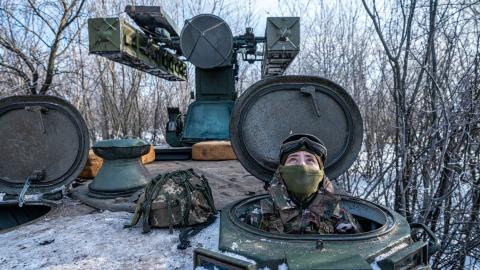Below Hudson Senior Fellow Can Kasapoğlu offers a military situation report about the war in Ukraine, focusing this week on Ukraine’s success in the skies.
1. Ukraine’s Air Defenses Score Several Noteworthy Kills
The Ukrainian Ministry of Defense reported last week that its air defenses destroyed 13 hostile combat aircraft within only 11 days. The butcher’s bill included one A-50 Beriev airborne early warning and control (AEW&C) aircraft, two Su-35 air-superiority fighters, and 10 Su-34 fighter-bombers of the Russian Aerospace Forces.
Last week’s edition of this report assessed how Russia’s invasion campaign would be hindered if it were to lose any of its A-50 Berievs. The Su-35, the air-superiority fighter that has long been on Iran’s wish list in exchange for providing drone and missile assistance to the Russian military, is another high-profile victim of Ukraine’s air defense prowess. But of all the aircraft the Kremlin lost last week, the Su-34 is the most significant.
2. Russia’s Diminishing Fleet of Su-34s Could Weaken Its Air Campaign
Only 100 of Russia’s initial fleet of 140 Su-34 fighter-bombers are thought to have survived the war thus far. Of these remaining aircraft, just 75 percent are estimated to be combat-ready. Since the Su-34, battle-tested during Russia’s involvement in Syria, is the country’s principal aircraft for launching precision-guided munitions (PGMs), significant losses of the fighter-bomber would likely reduce Russia’s ability to fire precision salvos against targets in Ukraine.
The Su-34 is perhaps the most unusual derivative of the Su-27 Flanker baseline. Equipped with an armored cockpit to withstand anti-aircraft ground fire, the aircraft is a twin-engine, twin-seat, supersonic fighter-bomber capable of operating in all weather. Enjoying a range of 2,500 miles without aerial refueling, the Su-34’s 12 external hardpoints can carry up to 30,000 pounds of munitions. It can deliver R-77, R-73, and R-27 air-to-air missiles, as well as a broad range of air-to-ground and anti-ship missiles. Compared to the Su-25’s SOLT-25 and the Su-24M’s Kaira-24 sensor configurations, the Su-34’s Platan retractable electro-optical sensor is the best in Russia’s arsenal. Possessing laser-designation capabilities that make it formidable in combat, the Su-34 is Russia’s strongest option in air-ground operations, although the system is nowhere near as robust as its American or European counterparts.
As Russia’s defense industry has focused on equipping legacy cluster and incendiary munitions with wings, effectively turning them into improvised glide bombs, the Su-34 has become the combat aircraft of choice for delivering those bombs. Thus, a significant attrition of Russia’s Su-34 arsenal would limit the Kremlin’s options.
According to estimates, the Russian Aerospace Forces’ recent combat aircraft losses exceed what its hampered defense industry can replace in a year by a factor of 20. Russian planners therefore face a dilemma: do they continue to use the Su-34 and risk the fleet’s further attrition, or employ a less effective alternative? Should the West opt to provide a significant boost to Ukraine’s air defense capabilities, Russia could lose half its Su-34 deterrent within a year. This, to put it mildly, would drastically affect the operational tempo of its air campaign.
3. Ukrainian Forces Find Success with the Innovative Use of Surface-to-Air Missiles
For some time, the Ukrainian military has been focusing its efforts on intercepting Russian combat aircraft in larger numbers. This approach to the conflict has paid off, leading to sensational kills, including the recent downing of three Su-34 aircraft within one day.
The likeliest explanation for Ukraine’s success is its combat deployment of high-end surface-to-air missile (SAM) systems closer to the front lines. Given the Russian Aerospace Forces’ poor capabilities in the destruction and suppression of enemy air defenses (DEAD and SEAD, respectively), this strategy carries manageable risks for Ukraine. The bulk of Ukraine’s SAM losses, moreover, have been inflicted by artillery and rocket salvos from Russian ground forces rather than by Russia’s air deterrent.
In addition to employing state-of-the-art Western systems, the Ukrainian defense technological and industrial base (DTIB) has reportedly retrofitted and modernized its legacy S-200 SAMs, giving an extra boost to the country’s air defenses.
4. Ukraine Risks Depleting Its Stock of Interceptor Missiles
While Ukraine’s air defenses have seen considerable success, Kyiv risks depleting its supply of interceptor missiles, especially its Patriot strategic SAMs and National Advanced Surface-to-Air Missile Systems (NASAMS).
For the short to medium altitudes, the West has sought to address this issue with an outside-the-box solution: the FrankenSAM system that combines Soviet-era launcher architecture with legacy Western Sea Sparrow and Sidewinder missiles. This unconventional solution scored its first kill in early 2024.
But Ukraine has no easy fix for refilling its diminishing stock of strategic interceptor missiles. Unless Kyiv’s Western providers replenish these assets, the launchers may be forced to remain idle except when engaging the most serious and direct threats.
5. Battlefield Assessment
Last week, Russia shifted its focus to occupying the territory surrounding Avdiivka after capturing the city, and made steady gains in implementing this strategy. Evidence suggests that Russian combat formations have advanced a few kilometers along a front line adjacent to the city, capturing multiple villages along the way. The situation unfolding around Avdiivka suggests that the Russian high command is pressing to move into Ukraine’s lines of defense.
At present, the main Russian push in Ukraine remains focused on the eastern sector, with another offensive occurring in the southern sector. Multiple clashes have occurred along this eastern line of contact, including in hotspots such as Bakhmut, Avdiivka, Marinka, and Kupiansk. In the south, most of last week’s positional clashes revolved around Robotyne and Krynky, where Russian forces are still working to dismantle the Ukrainian bridgehead across the Dnipro River.
Ukraine’s defensive efforts in Robotyne, the most important gain from its summer 2023 counteroffensive, remain strong, forestalling a large withdrawal. Reports from the battlefield suggest that Russian combat formations in the region currently involve elements from the 42nd Motor-Rifle Division, as well as the airborne troops (VDV). Russia continues to shell the area heavily.
Alongside the intense ground combat, Moscow has continued to pound Ukrainian cities with mixed strike packages featuring Russian missiles and Iranian loitering munitions. According to local reports, Russia also launched missile salvos from the occupied regions of Kherson and Donetsk.
On March 1, Russia attacked multiple cities, including Odesa, Mykolaiv, Zaporizhzhia, and Sumy. Ukrainian officials report that Ukraine successfully intercepted 14 of the 17 Shahed loitering munitions that Russia launched. The three drones that reached their targets, however, caused considerable damage and casualties in Odesa and Kharkiv, illustrating the difficulty of completely eradicating an offense-dominant regime.














